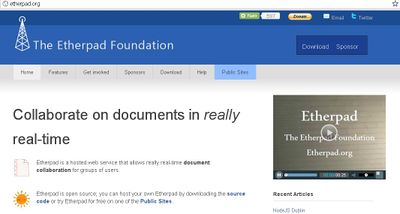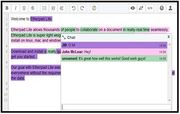Etherpad
Etherpad is a on line collaborative editor which supports real time editing. It allows authors to work simultaneously in collborative manner to edit a text document. All the authors can see each other’s edits in real-time.
Etherpad was launched in November 2008 by David Greenspan, Aaron Iba, and J.D. Zamfirescu. Later Daniel Clemens and designer David Cole joined the team. The original website was launched as etherpad.com. After intial hiccups the software was acquired by Google and released as open source in January 2009.
Etherpad supports displaying each author’s text in his or her own color. (See the figure showing three people using Etherpad)There is also a chat box in the sidebar to allow synchronous meta communication. How it works You may acess the etherpad on http://etherpad.org/. Etherpad is open source software such as Mediawiki about which you studied in Unit 2.3. You can host your own Etherpad by downloading the source code and installing on your server. Another way is to try Etherpad for free on one of the public sites like etherpad.mozilla.org/ – an Etherpad hosted by Mozilla. More can be seen on public sites
If you want to working on an etherpad go toopenetherpad and create your own pad to work on
Features
- Anyone can create a new collaborative document, known as a ‘pad’. Each pad has its own URL and anyone can access the particular etherpad using that URL and edit the document and collaborate. You may protect your pad with password (This feature is presently available with the Pro version). Each participant is identified by a color and a name (refer to figure).
- Etherpad also provides facility of auto-save at regular, short intervals. You may save specific versions (checkpoints) at any time. Merging of changes as handled by operational transform.
- A time slider feature allows anyone to explore the history of the pad.
- The document can be downloaded in plain text, html, Open document, Microsoft word or PDF format.
- Several services now use the Etherpad software, including PiratePad, Telecomix Pad, Framapad, Mozilla Pad (MoPad), PrimaryPad, TypeWith.me, Sync.in, TitanPad and iEtherPad.com.
- Etherpad Foundation coordinates the development of etherpad.
Though old etherpad is available a newer Etherpad Lite is also available through the Etherpad Foundation. It is an almost complete rewrite of the original Etherpad software, based on different technical foundations developed collaboratively. While the original Etherpad was written in scala and has bigger system requirements as compared to Etherpad Lite. It is written in server-side javascript. The original realtime synchronization library (calledEasysync) remains the same. Etherpad Lite is still evolving and has some distinctive features which are not available in the original version. Read more about Etherpad lite at https://github.com/Pita/etherpad-lite/wiki
Reference:


